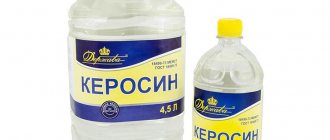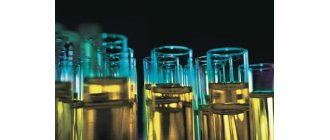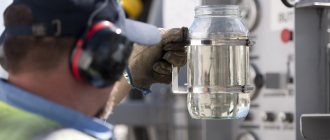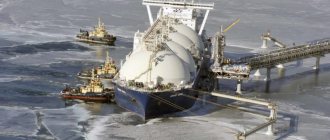Any type of fuel has a set of characteristics that determine its class and quality. One of the main indicators is the specific heat of combustion. This parameter quantitatively expresses the heat released during the combustion of one kilogram of fuel (if we are talking about a liquid or solid product) or 1 cubic meter of fuel (for a gaseous substance).
Why specific heat of combustion is an important characteristic for fuel, what lower heat is and what combustion temperature shows - we’ll talk about this in this article.
Specific heat of combustion of fuel
When completely burned, a certain amount of fuel releases a specific amount of heat. The more heat generated by one kilogram or liter of fuel (in this article we will mainly talk about liquid fuel), the more energy value it has. This means that fuel will be consumed economically.
In physics, the calculation formula is used: Q = q * m, where Q is the amount of heat released in J, q is the specific heat of combustion, expressed in J/m3, m is the mass in kilograms. The higher q, the more energy is obtained during engine operation.
Through complex research processes, the standard specific heat of combustion of most solid, liquid and gaseous fuels has been determined, so q is a tabular value. The specific heat of combustion of the most popular types of liquid mixtures ranges from 43-46 MJ/kg.
Problem No. 9
The efficiency of the shaft furnace is $60\%$. How much charcoal is needed to heat $10 \space 000 \space kg$ of cast iron from $20 \degree C$ to $1100 \degree C$?
Given: $\eta = 60 \% = 0.6$ $m_h = 10 \space 000 \space kg$ $c_h = 540 \frac{J}{kg \cdot \degree C}$ $t_1 = 20 \degree C$ $ t_2 = 1100 \degree C$ $q_у = 3.4 \cdot 10^7 \frac{J}{kg}$
$m_у — ?$
Show solution and answer
Hide
Solution:
Formula for the efficiency of a shaft furnace: $\eta = \frac{Q _h}{Q_y}$, where $Q_h$ is the amount of heat that must be imparted to the cast iron in order to heat it, $Q_y$ is the amount of heat that will be released during the combustion of wood coal of unknown mass.
Let us express $Q_у$ from here: $Q_у = \frac{Q_ч}{\eta}$.
The amount of heat that will be released during the combustion of charcoal is determined by the formula: $Q_у = q_у m_у$.
Let us express the mass of charcoal from here: $m_у = \frac{Q_у}{m_у}$.
Let us substitute here the found expression for $Q_у$: $m_у = \frac{\frac{Q_ч}{\eta}}{q_у} = \frac{Q_ч}{\eta \cdot q_у}$.
Let us separately calculate the value $Q_h$. The amount of heat required to heat cast iron: $Q_h = = c_h m_h (t_2 - t_1)$.
Let's calculate it: $Q_h = 540 \frac{J}{kg \cdot \degree C} \cdot 10 \space 000 \space kg \cdot (1100 \degree C - 20 \degree C) = 0.54 \cdot 10^7 \ frac{J}{kg} \cdot 1080 \degree C = 583.2 \cdot 10^7 \space J$.
Now we can calculate the required mass of charcoal: $m_у = \frac{583.2 \cdot 10^7 \space J}{0.6 \cdot 3.4 \cdot 10^7 \frac{J}{kg}} = \frac{583.2 \ space kg}{2.04} \approx 286 \space kg$.
Answer : $m_у \approx 286 \space kg$.
Heat of combustion lower and higher
Since determining the exact specific heat is a complex process, it is necessary to define the terms used in advance. In our case, we need to separate the low heat of combustion from the higher one.
Higher heat is the amount of heat during complete combustion of fuel, including the precipitation of condensation in the form of water vapor during cooling of substances. The combustion process is accompanied by the release of water due to the content of organic hydrogen in the fuel product; under the influence of high temperature, the water turns into steam. Lower heat does not include condensation of vapors - in this case, condensation is quantified as the latent heat of combustion.
In a research environment, the lower calorific value is taken as 100%, and cooling of the fuel is allowed to the temperature at which steam begins to condense. Everything else is referred to as the latent heat of combustion, which can additionally be over 10%.
It is not considered possible to correctly calculate the lower heat, therefore it is determined by subtracting from the quantitative expression of the higher heat of combustion the numerical expression of the heat obtained from the formation of water vapor of both the fuel itself and the combustion products. The lower heat value is a tabular value and for the main types of fuel is determined by testing.
Since q is defined as a reference value, it becomes easy to compare the appropriateness of using a particular type of fuel in different situations. Thanks to the compiled tables, you can compare the energy efficiency of solid and liquid fuels with their gas equivalent. Thus, one liter of gasoline is comparable in efficiency to 1.3 m3 of gas fuel.
Where does the heat come from during the combustion process?
The process of fuel combustion itself is a chemical, oxidative reaction. Most fuels contain large amounts of carbon C, hydrogen H, sulfur S and other substances. During combustion, the C, H, and S atoms combine with O2 oxygen atoms, resulting in molecules CO, CO2, H2O, SO2. In this case, a large amount of thermal energy is released, which people have learned to use for their own purposes.
Rice. 1. Types of fuel: coal, peat, oil, gas.
The main contribution to the heat release is made by carbon C. The second largest contribution to the amount of heat is made by hydrogen H.
Rice. 2. Carbon atoms react with oxygen atoms.
Specific heat of combustion of gasoline
The specific heat of combustion of gasoline does not depend on the octane number of the fuel and is determined only by the chemical composition of the product. The more hydrogen compounds it contains, the more moisture and vapor will be formed during combustion and the lower the specific heat will be. This directly reduces the efficiency of the product.
The specific heat of gasoline determined by the research method is 43.5–44.5 MJ/kg. For example, the numerical characteristic for AI-93 gasoline is 43.6 MJ/kg. But for aviation gasoline (B-70 in accordance with GOST) the figure is already 44.1 MJ/kg. This means that B-70 is a more energy efficient fuel.
In practice, it is difficult for a simple car enthusiast to determine the influence of the specific heat of combustion on the operation of a vehicle. However, there are situations in which there is a noticeable decrease in the amount of heat and energy of the fuel. One of them is the presence of mineral compounds and non-combustible residues in the fuel mass. The concentration of the combustible mass decreases, and mineral compounds and ash, which are not subject to combustion, take away part of the released energy.
The presence of a sulfur component in the fuel product also reduces q. During the heating and combustion process, sulfur releases gas, which settles on the internal parts of the working mechanism and enters the human lungs. This leads to the formation of corrosion and premature wear of working elements and pollutes the surrounding air. Therefore, it is very important to choose fuel that is free from most harmful impurities and refuel at proven gas station networks that monitor the reputation of the products they represent.
Brown coal
Brown coal is the youngest solid rock, formed about 50 million years ago from peat or lignite. At its core, it is “immature” coal.
This mineral got its name because of its color - shades vary from brownish-red to black. Brown coal is considered a fuel of low degree of carbonization (metamorphism). It contains 50% carbon, but also a lot of volatile substances, mineral impurities and moisture, so it burns much easier and produces more smoke and a burning smell.
Depending on the humidity, brown coal is divided into grades 1B (humidity more than 40%), 2B (30-40%) and 3B (up to 30%). The yield of volatile substances in brown coals is up to 50%.
With prolonged contact with air, brown coal tends to lose its structure and crack. Among all types of coal, it is considered the lowest quality fuel, since it emits much less heat: the calorific value of combustion is only 4000 - 5500 kcalkg.
Brown coal lies at shallow depths (up to 1 km), so it is much easier and cheaper to mine. However, in Russia it is used much less frequently as a fuel than coal. Due to its low cost, brown coal is still preferred by some small and private boiler houses and thermal power plants.
In Russia, the largest deposits of brown coal are located in the Kansk-Achinsk basin (Krasnoyarsk Territory). In total, the area has reserves of almost 640 billion tons (about 140 billion tons are suitable for open-pit mining).
The only coal deposit in Altai is Soltonskoye, which is rich in brown coal reserves. Its predicted reserves are 250 million tons.
About 2 trillion tons of brown coal are hidden in the Lena coal basin, located on the territory of Yakutia and the Krasnoyarsk Territory. In addition, this type of mineral often occurs together with coal - for example, it is also obtained from the deposits of the Minusinsk and Kuznetsk coal basins.
Specific heat of combustion of kerosene
The chemical structure of kerosene is a straight or branched chain of hydrocarbons; various additives and additives allow this petroleum distillate to be used for the mass supply of vehicles.
In order for the use of kerosene as a fuel to be justified, the selected brand of this combustible mixture must have a maximum specific heat of combustion. In the case of kerosene, the tabular determination of specific heat has an error - due to the variable composition of the fuel, which includes 4 types of hydrocarbons, as a result of which calculations have to be made based on the initial characteristics of the oil used.
It is possible to determine the optimal specific heat of combustion using the minimum combustion temperature of the liquid (+215 degrees) in the calculations. The closer the temperature is to this number, the higher the specific heat capacity of the product, and therefore the higher the specific heat of combustion. Already at +200 degrees, the heat capacity reaches 2900 J/kg*K. Under normal conditions, the specific heat of combustion of kerosene is 43 MJ/kg, with an error of 1000 points in any direction.
The specific heat indicator directly affects the combustion processes of kerosene inside engines. In addition, mechanisms operating on this petroleum product are subject to adiabatic processes due to the direct dependence of the pressure and volume of fuel inside the working chamber. The absence of heat exchange with the external environment leads to maximum energy efficiency of the kerosene used.
Due to the difficulty of determining the exact parameter of the specific heat of combustion of kerosene, to describe the chemical properties of this type of fuel, the specific heat capacity coefficient is preferably used (shows the ratio of the specific heat capacity at a constant volume and pressure level), which also has a constant insignificant error. The physical meaning of accurately calculating these quantities is in the subsequent determination of jet thrust and exhaust speed.
Units.
Conversion of units of measurement of specific heat of combustion (volume).
Specific heat calculator. Conversion of specific heat units (J/m3, kJ/m3, MJ/m3, cal/m3, kcal/m3, Mcal/m3, Gcal/m3, etc.)
Enter specific heat of combustion (Qv)
Result of conversion of units of measurement of specific heat of combustion (Qv)
Results of the specific heat calculator when converted to other specific heat units:
Examples of specific heat calculator results:
/ 9330 kJ/cub.m = 9.33 MJ/cub.m
//
1250 kJ/cub.m = 0.298558 cal/cub.m
//
1250 cal/cub.m = 5233.5 J/cub.m
//
813 kcal/cub.m .m = 3403870 J/cub.m
//
8133 kcal/cub.m = 34051200 J/cub.m
//
1250 cal/cub.m = 0.00125 Mcal/cub.m
/
Share a link to the calculation:
Conversion of units of measurement of specific heat of combustion (mass).
Specific heat calculator. Conversion of specific heat units (J/kg, kJ/kg, MJ/kg, cal/kg, kcal/kg, Mcal/kg, Gcal/kg, etc.)
Enter specific heat of combustion (Qm)
Result of conversion of units of measurement of specific heat of combustion (Qm)
Results of the specific heat calculator when converted to other specific heat units:
Examples of specific heat calculator results:
/ 5516 kcal/kg = 23.0944 MJ/kg
//
23 kcal/kg = 0.096296 MJ/kg
//
0 kJ/kg = 0 MJ/kg
//
18292 kJ/kg = 18.292 MJ/kg
//
1700 J/kg = 0.0017 MJ/kg
//
1250 cal/kg = 0.00125 Mcal/kg
/
Share a link to the calculation:
Units of measurement of specific heat of combustion (mass).
- joule per kilogram
is a SI unit of measurement.
Designation in Russia: J/kg . This unit of measurement is widely used in engineering calculations and in modern reference literature; - kilojoule per kilogram
is an SI unit of measurement.
Designation in Russia: kJ/k . This unit of measurement is widely used in engineering calculations and in modern reference literature; - Megajoule
kilogram is a SI unit of measurement.
Designation in Russia: MJ/k . This unit of measurement is widely used in engineering calculations and in modern reference literature; - calorie per kilogram - non-systemic units of measurement. Designation in Russia: cal /kg ;
- kilocalorie per kilogram - non-systemic units of measurement. Designation in Russia: kcal/kg ;
- Megacalories per kilogram are non-systemic units of measurement. Designation in Russia: Mcal/kg ;
- Gicacalorie per kilogram is a non-systemic unit of measurement. Designation in Russia: Gcal/kg .
Units of measurement of specific heat of combustion (volume).
- Joule per cubic meter
is a SI unit of measurement.
Designation in Russia: J/m3 . This unit of measurement is widely used in engineering calculations and in modern reference literature; - The kilojoule per cubic meter
is an SI unit of measurement.
Designation in Russia: k J/m3 . This unit of measurement is widely used in engineering calculations and in modern reference literature; - Megajoule
per cubic meter is an SI unit of measurement.
Designation in Russia: M J/m3 . This unit of measurement is widely used in engineering calculations and in modern reference literature; - calorie per cubic meter - non-systemic units of measurement. Designation in Russia: cal / m3;
- kilocalorie per cubic meter - non-systemic units of measurement. Designation in Russia: kcal/ m3;
- Megacalories per cubic meter are non-systemic units of measurement. Designation in Russia: Mcal/ m3;
- Gicacalorie per cubic meter is a non-systemic unit of measurement. Designation in Russia: Gcal/ m3.
Conversion of units of measurement of mass specific heat of combustion (in tabular form).
| Convertible units | Conversion of specific heat of combustion (mass) into units: | ||||||
| J/kg | kJ/kg | MJ/kg | cal/kg | kcal/kg | Mcal/kg | Gcal/kg | |
| J/kg | 1 | 10-3 | 10-6 | 0,238846 | 0,238846*10-3 | 0,238846*10-6 | 0,238846*10-9 |
| kJ/kg | 103 | 1 | 10—3 | 0,238846*10-3 | 0,238846*10-6 | 0,238846*10-9 | 0,238846*10-12 |
| MJ/kg | 106 | 103 | 1 | 0,238846*10-6 | 0,238846*10-9 | 0,238846*10-12 | 0,238846*10-15 |
| cal/kg | 4,1868 | 4,1868*10-3 | 4,1868*10-6 | 1 | 10-3 | 10-6 | 10-9 |
| kcal/kg | 4186,8 | 4,1868 | 4,1868*10-3 | 103 | 1 | 10-3 | 10-6 |
| Mcal/kg | 41868*102 | 4186,8 | 4,1868 | 106 | 103 | 1 | 10-3 |
| Gcal/kg | 41868*105 | 41868*102 | 4186,8 | 109 | 106 | 103 | 1 |
Conversion of units of measurement of volumetric specific heat of combustion (in tabular form).
| Convertible units | Conversion of specific heat of combustion (volume) into units: | ||||||
| J/ m3 | kJ/ m3 | MJ/ m3 | cal/ m3 | kcal/ m3 | Mcal/ m3 | Gcal/ m3 | |
| J/ m3 | 1 | 10-3 | 10-6 | 0,238846 | 0,238846*10-3 | 0,238846*10-6 | 0,238846*10-9 |
| kJ/ m3 | 103 | 1 | 10—3 | 0,238846*10-3 | 0,238846*10-6 | 0,238846*10-9 | 0,238846*10-12 |
| MJ/ m3 | 106 | 103 | 1 | 0,238846*10-6 | 0,238846*10-9 | 0,238846*10-12 | 0,238846*10-15 |
| cal/ m3 | 4,1868 | 4,1868*10-3 | 4,1868*10-6 | 1 | 10-3 | 10-6 | 10-9 |
| kcal/ m3 | 4186,8 | 4,1868 | 4,1868*10-3 | 103 | 1 | 10-3 | 10-6 |
| Mcal/ m3 | 41868*102 | 4186,8 | 4,1868 | 106 | 103 | 1 | 10-3 |
| Gcal/m3 | 41868*105 | 41868*102 | 4186,8 | 109 | 106 | 103 | 1 |
Specific heat of combustion of diesel fuel
The higher the specific heat of combustion of a diesel engine, the less volume of liquid is burned during engine operation. Consequently, fuel consumption will be economical. High specific heat is the main criterion for the energy efficiency of diesel fuel.
Thanks to research tests, the tabulated value of the specific heat of combustion of a diesel engine has clear boundaries and amounts to 39.2 – 43.3 MJ/kg. In different countries, the numbers may vary within these two boundaries.
For calculations regarding diesel fuel, only the lower specific heat of combustion is used, which does not include the energy generated during the formation and combustion of hydrogen compounds and the resulting water vapor. The lower specific heat of combustion of diesel fuel is lower than that of alkanes.
The energy efficiency of a diesel engine depends on the degree of viscosity of the liquid. The lower the viscosity, the higher the actual combustion temperature and the higher the lower specific heat of combustion of the fuel.
Features of a coal-fired furnace
Such a device has design features that involve the pyrolysis of coal. Charcoal is not a mineral; it has become a product of human activity.
The combustion temperature of coal is 900 degrees, which is accompanied by the release of a sufficient amount of thermal energy. What is the technology to create such an amazing product? The essence lies in a certain processing of wood, due to which a significant change in its structure occurs and excess moisture is released from it. A similar process is carried out in special ovens. The operating principle of such devices is based on the pyrolysis process. A charcoal furnace consists of four basic components:
- combustion chambers;
- reinforced foundation;
- chimney;
- recycling compartment.
Calorific value of fuel table
Since the specific heat of combustion is a reference value, we present a table with this indicator, determined individually in each case in the laboratory. The table contains information on the main types of fuel used for commercial and industrial purposes.
Table 1
Heat of combustion of fuel
| Name | Specific heat of combustion, MJ/kg |
| Acetylene | 48,3 |
| Hydrogen | 119,83 |
| Propane-butane | 43,8 |
| Isobutane | 45,6 |
| Methane | 50 |
| n-hexane | 45,1 |
| Natural gas | 41…49 |
| Liquefied gas | 45,2 |
| Propane | 46,3 |
| Propylene | 45,8 |
| Ethane | 47,5 |
| AI-72 gasoline | 44,2 |
| AI-93 gasoline | 43,6 |
| Aviation gasoline B-70 | 44,1 |
| Diesel fuel | 43,4 – 43,6 |
| Rocket fuel with kerosene | 9,2 |
| Aviation kerosene | 42,9 |
| Fuel oil | 39 – 41,7 |
| Methanol | 21,1 |
| Butanol-1 | 36,8 |
| Oil | 43,5 – 46 |
| Ethanol | 30,6 |
| Toluene | 40,9 |
#Gasoline#Kerosene#Diesel fuel
The required amount of fuel to operate a 100 W light bulb for a year
(The amount of fuel indicated is below 100% efficiency in converting thermal energy into electrical energy. Since most electric generators and distribution systems achieve efficiency (efficiencies) of about 30% - 35%, the actual amount of fuel used to power a 100 W light bulb will be approximately three times more than the specified amount).
- 166 kg wood
- 117–210 kg of coal
- 73.34 kg kerosene
- 78.8 m³ natural gas (using an average value of 40,000 kJ/m³)
- 58 kg methane
- 0.006 kg uranium
- 17.5 µg antimatter
Firewood
These are sawn or chopped pieces of wood, which, when burned in furnaces, boilers and other devices, generate thermal energy.
For ease of loading into the firebox, wood material is cut into individual elements up to 30 cm long. To increase the efficiency of their use, the firewood must be as dry as possible and the combustion process must be relatively slow. In many respects, wood from hardwoods such as oak and birch, hazel and ash, and hawthorn are suitable for heating premises. Due to the high resin content, increased burning rate and low calorific value, coniferous trees are significantly inferior in this regard.
Burning rules
When a consumer becomes familiar with the combustion temperature of a particular coal, he needs to take into account that manufacturers indicate only those figures that are relevant for ideal conditions. Of course, it is simply impossible to recreate the necessary parameters in an ordinary household boiler or oven. Modern heat generators made of metal or brick are simply not designed for such high temperatures, since the main coolant in the system can quickly boil. That is why the combustion parameters of a particular fuel are determined by its combustion mode.
In other words, it all depends on the intensity of the air supply. Both fossil and charcoal heat a room well if the oxygen supply level reaches 100%. To restrict the air flow, you can use a special damper/gate. This approach makes it possible to create the most favorable combustion conditions for filled fuel (up to 950˚C).
If coal is used in a solid fuel boiler, then boiling of the coolant must not be allowed. The main danger is that the safety valve may simply not work, which can lead to a large explosion. In addition, a mixture of water and hot steam has a bad effect on the functionality of the circulation pump. Experts have developed two most effective methods that allow you to control the combustion process:
- Crushed or powdered fuel must enter the boiler exclusively in a dosed volume (the same scheme applies as in pellet devices).
- The main energy carrier is loaded into the firebox, after which the intensity of the air supply is adjusted.








